CARROLL
Lewis (1832-1898)

Lewis Carroll is the
pseudonym of the English
writer and mathematician
Charles Lutwidge Dodgson,
born on January 27th 1832
He is known especially
for "Alice's Adventures
in Wonderland"
(1865) and "Through
the Looking Glass"
(1872) : child ren's
books that are also dis
tinguished as satire and
as exam ples of verbal
wit. Carroll
invented his pen name
by translating his first
two na mes into the Latin
"Caro- lus Lodovicus"
and then anglicizing it
into "Lewis Carroll."
The
son of a clergyman and the
first born of 11 children,
Carroll began at an ear
ly age to entertain himself
and his family with magic
tricks, marionette
shows, and poems written
for homemade newspapers.
From 1846 to 1850 he attended
Rugby School; he graduated
from Christ Church College,
Oxford, in 1854. Carroll
remained there, lectu-
ring on mathematics
and writing treatises and
guides for students. Al
though he took deacon's
orders in 1861, Carroll
was never ordained a priest,
partly because he was afflicted
with a stammer that
made prea ching difficult
and partly, perhaps, because
he had discovered other
interests. He excelled especially
at photographing children.
Alice Lid- dell, one of
the three daughters of Henry
George Liddell, the dean
of Christ Church, was one
of his photographic subjects
and the model for the fictional
Alice. Car roll's comic
and children's works also
include "The Hunting
of the Snark" (1876)
two collections of humorous
verse, and the two parts
of "Sylvie and Bruno"
(1889, 1893), unsuccessful
attempts to re-create
the Alice fantasies. As
a ma thematician, Carroll
was conservative. As a logician,
he was more interested in
logic as a game than as
an instrument for testing
reason. He contributed,
in "Jabberwocky," the word
chortle, a portmanteau word
that combines "snort"
and "chuckle," to
the English language.
wit
: jeux de mots, esprit
entertain himself :
se divertir
tricks
: ruses, astuces
attended : a suivi les
cours
lecturing
: a fait des ocnférences
deacon : diacre
stammer : bégaiement
attemps
: tentaives
snort : grognement
chuckle : gloussement
Alice's
Adventures in Wonderland
(1865)
Through
the Looking Glass (1872)
TOP of the page
CHRISTIE
Agatha
(1890-1976)
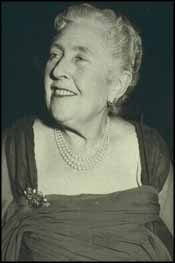
Agatha Chrisite was
born in Torquay, in the
county of Devon, as the
daughter of Frederick Alvah
Miller, an American with
a moderate private income,
and Clarissa Miller. Her
father died when she was
a child. Christie was educated
home, where her mother encouraged
her to write from very early
age. At sixteen she was
sent to school in Paris
where she studied singing
and piano. Christie was
an accomplished pianist
but her stage fright
and shyness prevented
her from pursuing a career
in music. In her books Christie
seldom referred to music,
although her detectives,
Poirot and Miss Marple,
show interest in opera and
Poirot sings in "The
A.B.C. Murders"
(1936) a World War I
song. When Christie's mother
took her to Cairo
for a winter, she wrote
there a novel. Encouraged
by Eden Philpotts, neighbour
and friend in Torquay, she
devoted herself into
writing and had short stories
published.
In
1914 Christie married Archibald
Christie, an officer in
the Flying Royal Corps;
their daughter, Rosalind,
was born in 1919. During
World War I she worked in
a Red Cross Hospital in
Torquayas a hospital dispenser,
which gave her a knowledge
of poisons. It was to be
useful when she started
writing mysteries. Christie's
first detective novel, "The
Mysterious Affair at Styles",
introduced Hercule Poirot,
the Belgian detective, who
appeared in more than 40
books, the last of which
was "Curtain"
(1975). The Christies bought
a house and named it 'Styles'
after the first novel. Poirot
was an amiably comic character
with egg-shaped head,
eccentric whose friend Captain
Hastings represents the
"idiot narrator" - familiar
from Sherlock Holmes stories.
Poirot draws conclusions
from observing people's
conduct and from objects
around him, creating a chain
of facts that finally reveal
the murderer. '"He
tapped his forehead. "These
little grey cells.
It is 'up to them' - as
you say over here."' Behind
the apparently separate
details is always a pattern,
which only Poirot is able
to see.
Miss
Marple, an elderly
spinster, was a typical
English character, but when
Poirot used logic and rational
methods, Marple relied on
her feminine sensitivity
and empathy to solve
crimes. She was born and
lived in the village of
St. Mary Mead. Both Poirot
and Marple did not have
any family life, but Poirot
also travelled much. Marple
was featured in 17 novels,
the first being "Murder
at the Vicarage"(1930)
and the last "Sleeping
Murder"(1977).
She was reportedly based
on the author's own grandmother.
Miss Marple made her first
screen appearance in 1961
in "Murder She Said",
starring Margaret Rutherford.
It was based on the novel
"4:50 From Paddington"(1957).
It was followed by "Murder
at the Galop" (1963),
"Murder Ahoy"
(1964), and "Murder
Most Foul" (1964),
all directed by George Pollock.
The BBC TV series starring
Joan Hickson ran 1984-87.
Gracie Fields played Miss
Marple on television in
an adaptation of "A
Murder Is Announced"
(1956).
Christie's
marriage broke up in 1926.
Archie Christie, who worked
in the City, announced
that he had fallen in love
with a younger woman, Nancy
Neele. In the same year
Christie's beloved mother
died. After hearing that
her husband had left for
Miss Neele's house, Christie
disappeared for a time.
"I would gladly give £500
if I could only hear where
my wife is," said Colonel
Christie. The story of her
real life adventure in 1926,
when she lived in a Harrowgate
hotel under the name Mrs.
Neele, was basis for the
film Agatha. It was directed
in 1978 by Michael Apted.
In title role was Vanessa
Redgrave. Christie's divorce
was finalized in 1928, and
two years later she married
the archaeologist Max Mallowan.
She had met him on her travels
in Near East in 1927,
and accompanied him on his
excavations of sites in
Syria and Iraq. Later Christie
used these exotic settings
in her novels "Murder
in Mesopotamia"
(1936) and Death on the
Nile (1937). Her own archeological
adventures were recounted
in "Come Tell me
How you Live" (1946).
Mallowan was Catholic and
fourteen years her junior;
he became one of the most
prominent archaeologist
of his generation. Of her
marriage the writer told
reporters: "An archaeologist
is the best husband any
woman can have. The older
she gets, the more interested
he is in her." Mallowan
worked in Iraq in the 1950s
but returned to England,
when Christie's health
grew weaker. His most famous
book was "Nimrud
and its Remains".
Christie's
most prolific period began
in the late 1920s. During
the 1930s he published four
non-series mystery novels,
fourteen Poirot novels,
two Marple novels among
others. During WW II
Christie worked in the dispensary
of University College Hospital
in London. She also produced
twelve completed novels.
By
1955 Christie had become
a limited company, Agatha
Christie Ltd, which was
acquired in the late 1960s
by Booker Books. It had
already acquired Ian Fleming.
In 1967 Christie became
president of the British
Detection Club, and in 1971
she was made a Dame of the
British Empire. Christie
died on January 12th 1976
in Wallingford, Oxforshire.
Mallowan died two years
later, but he had married
after Christie's death an
old family friend. With
over one hundred novels
and over one hundred translations
into foreign languages,
Christie was by the time
of her death the best-selling
English novelist of all
time. As Margery Allingham
said: Christie has "entertained
more people for more hours
at time that any other writer
of her generation." (New
York Times Book Review,
1950)
stage
fright : la peur de
la scène
shyness : timidité
World War I (WWI)
: première guerre
mondiale
Cairo : Le Caire
devoted herself to :
se consacra à
knowledge : savoir,
connaissance
egg-shaped
: à
la forme d'un oeuf
murderer : meurtrier
little
grey cells : petites
cellules grises
pattern : structure,
réseau
elderly
:
âgé
spinster : vieille
fille
empathy : compassion
The
City :
La City (à Londres)
Near East : le Proche-Orient
settings
: décors
health : santé
among others : entre
autres
translations
: traductions
entertained : a diverti
The
Murder of Roger Ackroyd
(1926)
In
the quiet village of Kingís
Abbot a widowís suicide
has stirred suspicion
ñ and dreadful gossip.
There are rumours she murdered
her first husband, that
she was being blackmailed
and that her secret lover
was Roger Ackroyd. Then
Ackroyd is found murdered
- and all the members of
the household stand to gain
from his death. Hercule
Poirot, who has retired
to Kingís Abbot to grow
vegetable marrows, is reluctantly
drawn into finding an extremely
clever, and devious,
killer.
(a
semé - commérages
- a
fait du chantage - sournois)
The
Murder at the Vicarage (1930)
The
murder of Colonel Protheroe
is a shock to everyone in
St. Mary Mead, though hardly
an unpleasant one. Now the
vicar, who had declared
that killing the detested
Protheroe would be a service
to the world, as well as
his young and flirtatious
wife, could be considered
suspects. And what about
the faithless Mrs.
Protheroe, or her lover,
the young artist Lawrence
Redding? Jane Marple is
at her shrewdest
in this delightfully intricate
mystery.
(à
peine - vicaire - perfide
- la plus perspicace - complexe)
Murder
on the Orient Express (1934)
- worksheets
Just
after midnight, a snowdrift
stops the Orient Express
in its tracks. The luxurious
train is surprisingly full
for the time of year. But
by the morning there is
one passenger less. An American
lies dead in his
compartment, stabbed
a dozen times, his door
locked from the insideÖRed
herrings galore are
put in the path of Hercule
Poirot to try and keep him
off the scent but in a dramatic
dÈnouement he succeeds in
coming up with not one,
but two solutions to the
crime.
(congère
- mort - poignardé
- fausses pistes)
Death
on the Nile (1937)
Linnet
Doyle is young, beautiful,
and rich. She's the girl
who has everything - including
the man her best friend
loves. Linnet and her new
husband take a cruise
on the Nile, where they
meet the brilliant detective
Hercule Poirot. It should
be an idyllic trip, yet
Poirot has a vague, uneasy
feeling that something is
dangerously amiss...
(croisière
- qui cloche)
TOP
of the page
DAHL
Lamb
to the Slaughter
01
02
03
04
DEFOE
Daniel
(1660-1731)

Daniel Defoe was born
in London in 1660, the son
of a butcher named James
Foe. He changed his name
when he became a writer
circa 1695, although
it was not his only pseudonym
: others included "Eye Wit-
ness", "Andrew Morton, Merchant",
and amusingly, "Heliostropolis,
se- cretary to the emperor
of the Moon". Initially,
Defoe spent time at Mor
ton's academy for Dissenters
but following certain travels
on the conti- nent that
took in France and Spain,
he settled down as a hosiery
mer- chant in Cornhill and
married Mary Tuffley. Defoe
took part in Mon- mouth's
rebellion and it was whilst
in hiding after the Duke
of Mon- mouth's execution
that he noticed the name
"Robinson Crusoe" in a churchyard,
carved on a stone. He recalled
the name and it became the
title of his most famous
hero some thirty-four years
later. In 1688, Defoe joined
the forces of William III.
In the late 1690s, his first
important work began to
appear, with "An
Essay upon Projects"
(1697) and the extremely
popular satirical poem "The
True-Born English man"
(1701). Defoe's ironic pamphlet
"The Shortest Way
with Dissenters "
(1702) demanded the total
suppression of dissent -
he himself was a Dissenter
- and got him imprisoned.
This unfortunate
circumstance turned out
to be a triumph for the
writer, however. While he
stood in the pillory for
three days, the crowd bought
copies of and then chanted
his "Hymn to the Pillory",that
he had written in prison.
A Tory politician
Harley, managed to get Defoe
a pardon and gave him new
employ- ment as a secret
agent, which he held between
1703 and 1714. Defoe wrote
numerous pamphlets for Harley
and also began A Weekly
Re- view of the Affairs
of France (later A Review
of the State of the British
Nation). Defoe wrote this
paper three times weekly
and almost entirely on his
own, providing not only
political discussion but
lighter pieces on love and
gambling for example.
He was imprisoned again,
briefly, for anti-Jacobite
pamphlets in the early 1710s
and was convicted of libel-ling
Lord Annesley in 1715.
It
was in his later years,
that Defoe wrote the novels
for which he is now famous.
They brought him great success.
1719's "Robinson
Cru- soe" and its
sequel, "the Farther
Adventures of Robinson Crusoe",
are pro bably the most famous,
but soon he had published
"Captain Single
ton" (1720), "Moll
Flanders" (1722),
"A Journal of the
Plague Year" (1722)
and "Roxana"
(1724). These novels were
extremely influential and
showed a journalist's interest
in realistic description.
Many of the works written
after Roxana were travel
books (e.g. "A New
Voyage round the World"
(1724) and "A Tour
through the Whole Island
of Great Britain"
(1724-6)). Defoe's simple
but effective prose style
ensured him widespread
po- pularity and he is seen
as the father of the English
Novel, as well as the first
journalist of great individual
merit.
circa
: vers
hosiery : bonneterie
churchyard : cimetière
unfortunate
: malheureux
Tory : parti conservateur
anglais
gambling
: jeux d'argent
libelling : calomnie
widespread
: considérable
Resource
PAGE
Robinson
Crusoe (1719)
Full
TEXT
A
shipwrecked survivor is
washed up on a deserted
island, where he li ves
alone until he rescues a
savage. Naming the man Friday,
the two continue their lonely
existence until they leave
for England. Crusoe's tale
spans 28 years and is probably
based on the true story
of Alexan der Selkirk, who
lived on a deserted island
for five years.
TOP
of the page
DICKENS
Charles
(1812-1870)
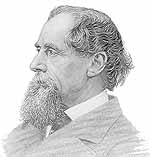
Charles Dickens was
born in Portsmouth, England
on February 7th 1812, the
second of eight children.
His father was a clerk working
for the Navy Pay office and
was imprisoned for debt when
Charles was very young. Due
to the lack of funds, Dickens
went to work at a blacking
warehouse when he was
twelve. His brush with hard
times and poverty affected
him deeply, and he later recounted
his experiences in the semi-autobiographical
"David Copperfield".
A concern for social justice
and reform which surfaced
later on in his writings,
grew out of the neglect and
harsh conditions he experienced
in the warehouse. Although
he had little formal schooling,
he was able to teach himself
shorthand, leading
him to a job as a parliamentary
reporter at a newspaper. While
he published several sketches
in magazines, it was not until
he wrote "The Pickwick
Papers" from 1836-7
that he experienced true success.
A publishing phenomenon, it
was published in monthly installments
and sold over forty thousand
copies for each issue.
The year 1836 also saw his
marriage to a Catherine Hogarth,
who was the daughter of a
fellow co-worker at the newspaper.
Their marriage was not a happy
one, but tthey had ten children
before their separation in
1858.
"Oliver
Twist" and "Nicholas
Nickleby" followed;
both were published in monthly
installments and reflected
simultaneously Dickens'
understanding of the underclass
and his comedic genius.
In 1843, Dickens published
one of his most famous works,
"A Christmas Carol".
In this story , it was evident
how Dickens was becoming
disenchanted with the economic
philosophy of the world;
he blamed much of
society's ills on
people's obsession with
earning money and acquiring
a status based on money.
His travels abroad, first
to America and then all
over Europe, in the 1840s
began a different stage
in his life. His writings
became more serious and
involved more planning on
his part. In "David
Copperfield" (1849-50)
the reader found the same
flawed world that
Dickens had discovered as
a young boy. Other novels
were to follow. In the weekly
periodicals he started,
"Household Words"
(1850) and "All the Year
Round" (1859), he published
such well-known novels as
"Tale of Two Cities"
and "Great Expectations".
Dickens first thought of
setting a novel in the time
of the French Revolution.
A year later, Dickens went
through his own form of
social change as he wrote
the novel; he separated
from his wife, and revitalized
his career by making plans
for a new weekly literary
journal called "All
the Year Round".
In 1859, "A Tale
of Two Cities"
premiered in parts in this
journal. It was popular,
not only from the fame of
its author, but also for
its short length
and radical (for Dickens)
subject matter. Dickens'
health started deteriorating
in the 1860s. He started
public readings of his works
in 1858 : he became very
tired. On June 9th 1870,
Charles Dickens died and
was buried in the Poet's
Corner of Westminster Abbey.
Though "The
Mystery of Edwin Drood"
was unfinished at the time
of his death, he had written
fifteen substantial novels
and countless shorter pieces.
His legacy is clear. While
he pointed out problems
within societyña blinding
and mercenary greed
for money, in all sectors
in society, and a wrong
inequality, he offered us,
at the same time, a solution.
Through his books, we come
to understand the virtues
of a loving heart and the
pleasures of home in a flawed,
cruelly indifferent world.
In the end, the lesson to
take away from his stories
is a positive one. Dickens'
writings have shown readers
over generations the reward
of being truly human.
blacking
: cirage
warehouse : entrepôt
shorthand : sténographie
sketches
: croquis, esquisse
installment : épisode
copies
: exemplaires
blamed : condamner
ills : maux
flawed
: imparfait
length : longueur
though (although)
: bien que
blinding
: aveuglant
greed : avidité,
cupidité
reward : récompense
Oliver
Twist (1837-9)
A
Christmas Carol (1843)
David
Copperfield (1848-9)
A
Tale of Two Cities (1859)
Recreational
resources
on Dickens
Dickens
Page
novels, characters, glossary,
illustrations, timeline,
London map, FAQ...
TOP
of the page
DOYLE
Sir
Arthur Conan (1859-1930)
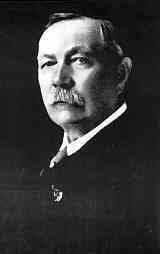
Arthur Conan Doyle
was born to a family of
Roman Catholics in Edin-
burgh, in 1859. His father,
Charles, was a civil
servant who suffered
from epilepsy and alcoholism.
He was educated in Jesuit
schools and eventually
lost his faith in
Catholicism in favor of
his Jesuit training. He
later used his friends and
teachers from Stonyhurst
College as ins piration
for characters in his Holmes
stories. Doyle married Louise
Haw kins in 1884 and then
in 1885 he graduated
as a doctor from Edin- burgh
University. After graduation
Doyle practiced medicine
and spe- cialized in eye
care in Hampshire. He remained
there until 1891 when he
became a full time writer.
His first story, a Sherlock
Holmes novel was called
"A Study in Scarlet"(1887).
Doyle
followed his first novel
with "The Sign of
Four" and then
in 1891 "The Adventures
of Sherlock Holmes"
was published by the Strand
Magazine. His works were
met with public approval
and he soon became quite
popular, in fact he became,
in the 1920s, one of the
highest paid writers in
the world. But the massive
initial popularity had an
affect on Doyle and by the
end of 1891 he had
sworn to end the
series, which he thought
he achieved by killing
Sherlock Holmes in "The
Final Problem",
which was published in December
of 1893.
During
the South African War (1899-1902)
Doyle served as a physician
in a field hospital, where
he wrote "The Great
Boer War" in which
he de- fended the policy
of his homeland.
After the war, in 1902,
Doyle retur ned to England
and was knighted.
He then took up the pen
again for the revered detective
and published "The
Hound of the Baskervilles",
a prequel, in 1902.
He then resurrected his
dead logician in "The
Empty House" and
continued writing short
stories about Holmes and
Watson. In 1906 Doyle ran
for Parliament but failed
to be elected, the next
year his wife, long ill,
died. Shortly after his
wife's death Doyle remar-
ried to Jean Leckie. Then,
in WWI, his son died. This
was a tragedy for Doyle
and it affected him deeply.
As a result he dedicated
the rest of his life to
spiritual causes. His last
book, a collection of short
stories known as "The
Casebook of Sherlock Holmes"
was published in 1927. Doyle
died of heart disease on
July 7th 1930.
civil
servant : fonctionnaire
eventually : finalement
faith : foi
graduated
: a été diplômé
sworn : avait juré
achieved : réussi
policy
:
politique
homeland : patrie
prequel : événements
antérieurs
failed
: a échoué
The
Adventures of Sherlock Holmes
The
Hound of the Baskervilles
TOP
of the page
SHAKESPEARE
William
(1564-1616)
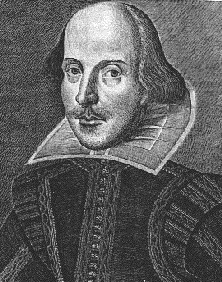
William
Shakespeare was born on
April 23rd 1564 to John
Shakespeare and mother Mary
Arden some time in late
April 1564 in Stratford-upon-Avon.
. His father was a prominent
and prosperous alderman
in the town of Stratford-upon-Avon,
and was later granted a
coat of arms by the College
of Heralds. All that is
known of Shakespeare's youth
is that he presumably attended
the Stratford Grammar School,
and did not proceed to Oxford
or Cambridge. He married
Anne Hathaway in 1582. The
next year she bore a daughter
for him, Susanna, followed
by the twins Judith
and Hamnet two years later.
Seven
years later Shakespeare
was recognized as an actor,
poet, and playwright,
when a rival playwright,
Robert Greene, referred
to him as "an upstart crow"
in "A Groatsworth of Wit."
A few years later he joined
up with one of the most
successful acting troupes
in London: "The Lord Chamberlain's
Men." When, in 1599, the
troupe lost the lease
of the theatre where they
performed (appropriately
called "The Theatre"), they
were wealthy enough
to build their own theatre
across the Thames, south
of London, which they called
"The
Globe" The new theatre
opened in July of 1599,
built from the timbers of
"The Theatre", with the
motto "Totus mundus
agit histrionem" (A whole
world of players). When
James I came to the throne
(1603) the troupe was designated
by the new king as the "King's
Men" (or "King's Company").
The Letters Patent of the
company specifically charged
Shakespeare and eight others
"freely to use and exercise
the art and faculty of playing
Comedies, Tragedies, Histories,
Interludes, Morals, Pastorals,
stage plays ... as well
for recreation of our loving
subjects as for our solace
and pleasure."
Shakespeare
entertained the King
and the people for another
ten years until June 19th
1613, when a canon fired
from the roof of
the theatre for a gala performance
of Henry VIII set fire to
the thatch roof and
burned the theatre to the
ground. The audience ignored
the smoke from the roof
at first, being to absorbed
in the play, until the flames
caught the walls and the
fabric of the curtains.
Amazingly there were no
casualties, and the
next spring the company
had the theatre "new builded
in a far fairer manner than
before." Although Shakespeare
invested in the rebuilding,
he retired from the stage
to the Great House of New
Place in Statford that he
had purchased in
1597, and some considerable
land holdings ,where he
continued to write until
his death in 1616 on the
day of his 52nd birthday.
alderman
: conseiller municipal,
échevin
twins : jumeaux
playwright
:
dramaturge
lease : bail
wealthy : aisé,
riche
motto
: devise
entertained : a diverti
roof : toit
thatch : chaum
casualities
: blessés
purchased : a acheté
Complete
biography
Tragedies
- Histories - Comedies -
Poetry
here
TOP
of the page
STEVENSON
Robert
Louis (1850-1894)
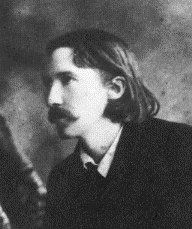
Robert
Lewis Balfour Stevenson
was born in 1850 in Edinburgh.
He was the only son of Thomas
Stevenson, a prosperous
joint-engineer to
the Board of Northern Lighthouses,
and Margaret Balfour, daughter
of a Scottish clergyman.
Thomas Stevenson invented,
among others, the marine
dynamometer, which measures
the force of waves. Thomas's
grandfather was Britain's
greatest builder of lighthouses.
Stevenson was largely raised
by his nanny, Alison
Cunningham, whom he devoted
"A Child's Garden
of Verses" (1885).
Since his childhood, Stevenson
suffered from tuberculosis.
During his early years,
he spent much of his time
in bed, composing stories
before he had learned to
read. At the age of sixteen
he produced a short historical
tale. As an adult, there
were times when Stevenson
could not wear a jacket
for fear of bringing on
a haemorrhage of the lung.
In 1867 he entered Edinburgh
University to study engineering.
Due to his ill health,
he had to abandon his plans
to follow in his father's
footsteps. Stevenson changed
to law and in 1875
he was called to the Scottish
bar. By then he had
already started to write
travel sketches, essays,
and short stories for magazines.
His first articles were
published in The Edinburgh
University Magazine (1871)
and The Portofolio (1873).
In
a attempt to improve
his health, Stevenson travelled
on the Continent and in
the Scottish Highland. These
experiences provided much
material for his writings.
An account of Stevenson's
canoe tour of France and
Belgium was published in
1878 as "An Inland
Voyage". It was
followed by "Travels
with a Donkey in the Cévennes",
based on his walking trip
in France. "I travel for
travel's sake," Stevenson
wrote. "The great affair
is to move." While in France
Stevenson met Fanny Vandegrift
Osbourne, a married woman
with two children, Belle
and Lloyd. She returned
to the United States to
get a divorce. In 1879 Stevenson
followed her to California
where they married in 1880.
Stevenson gained first fame
with the romantic adventure
story "Treasure
Island", which
appeared first serialized
in Young Folks 1881-82.
Before it was published
in book form Stevenson revised
the text. The Strange Case
of Dr Jekyll and Mr Hyde,
published in January of
1886, sold 40,000 copies
in six months in Britain.
Stevenson said later that
its plot was revealed
to him in a dream.
Stevenson's
father died in 1887. From
the late 1880s Stevenson
lived with his family in
the South Seas, where he
had purchased
an estate in Vailima, Samoa.
Stevenson died of a brain
haemorrhage on December
3, 1894, in Vailima. Fanny
Stevenson died in 1914 in
California. Her ashes
were taken to Samoa and
buried alonside her husband,
on the summit of Mount Vaea.
Stevenson's last work, "Weir
of Hermiston" (1896),
was left unfinished, but
is considered his masterpiece.
Stevenson's best-known work
of horror, The Strange Case
of Dr. Jekyll and Mr. Hyde
has since his death inspired
several sequels by
other hands, including Dr.
Jekyll and Mr. Holmes by
Loren D. Estelman (1979),
Jekyll, Alias Hyde: A Variation
by Donald Thomas (1988),
The Jekyll Legacy by Robert
Bloch and Andre Norton (1990)
and Mary Reilly by Valrie
Matin (1990) with Julia
Roberts and John Malkovitch.
engineer : ingénieur
lighthouses : phares
nanny : nourrice
ill
heath : mauvaise santé
law : le droit
bar : s'inscrire au
barreau
improve
: améliorer
fame : gloire, renommée
plot : intrigue, histoire
had
purchased : avait acheté
ashes : cendres
sequels : suites
Travels
with a Donkey in the Cévennes
Treasure
Island
The
Strange Case of Dr Jekyll
and Mr Hyde
TOP
of the page